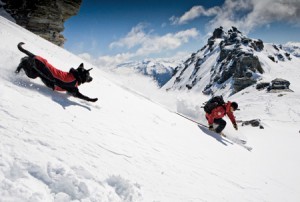- Tahoe’s Nevada Beach Tops the List of Hard-to-Book Campgrounds - 07/17/2024
- Cannabis Watershed Protection Program Cleans Up Illegal Grow Sites - 07/10/2024
- French Fire - 07/05/2024
Winterizing Your Dog is Nothing to Sniff At
By Angela Hook
Imagine yourself having to wear only one set of clothes, all year round, inside and out, whatever the weather conditions or activity. Imagine going from beside the fire to outside for a walk without putting on an extra layer.
It’s easy to forget that under that fur is flesh and blood, and that changes in temperature can have an impact on your dog’s health, wellbeing and enjoyment of activity with you over the winter months.
Fur is just fur – it doesn’t make your dog impervious to cold, visible in all conditions or waterproof. It does not give dogs super powers. It does not make a dog thermo-dynamic. It’s only fur! If it was as good as many of us think, we’d all have it!
There are some simple things you can do to help keep your pooch more safe and comfortable over the winter. Equipping your dog for the weather conditions is smart, not soft. Dogs that are warm and dry work and play with more enthusiasm, suffer fewer health issues and joint problems, require less food and let’s face it — a dry, clean dog is far nicer to have on your rug or in your car than a wet, dirty one.
Grrr … It’s Brrr
Dogs do suffer from cold related distress, particularly where conditions are wet and/or windy, if they are going from warm to cool areas, or from activity to rest outside. A reduction in their internal body temperature of even a few degrees below their normal 101.5 – 102.5F will bring on the effects of hypothermia.
Just like in humans, cold can interfere with normal metabolic functions and affect the internal organs. Watch for changes in energy levels, breathing and coordination. If your dog shows any of these signs warm them quickly and immediately using jackets, blankets and hot water bottles if possible.
Dogs also suffer from frostbite. Generally this affects the tips of the ears, paws, tail and in male dogs around the scrotum area – Well, imagine what would happen if you dragged your undercarriage through the snow!
Watch for skin that appears pale and is cold to the touch. Unlike treating hypothermia it is important to warm these areas slowly. As the blood returns the area may become red and swollen and will be painful. Monitor this closely and seek the advice of your vet if you suspect your dog has frostbite.
Often prevention is better than a cure, so if it’s cold or wet consider a jacket for your dog. If Rover is short haired, a little thermally fragile, old or suffering from any kind of joint stiffness look for jackets that are light, warm and preferably breathable with good coverage over the belly, body and hips. This will help to insulate and stabilize their body temperature as they go from one temperature to another or from activity to rest.
If your dog has longer fur or a thicker coat a jacket could still benefit them by keeping them dry and clean through the winter. Again look for coats that offer protection without too much weight, cover their bodies right over the hips and don’t impede their movement.
Booties can be useful for winter hounds as they protect the pads of your dog’s paws from coarse or packed snow that can aggravate the pads and accumulate in the hair in between the pads. If your dog has long hair between its paws, consider trimming this to avoid snow packing in between the pads (imagine having snow packed between your bare toes). Like coats, look for boots that are light and have the least impact on your dog’s gait. Be prepared to lose a few as despite the best attempts of some excellent companies, dogs just aren’t very good at wearing shoes.
Be Safe, Be Seen
Winter can be a dangerous time for dogs out in both urban and wilderness areas. Consider high visibility gear for your dog when walking in winter traffic and anywhere that dogs can be mistaken for deer or other hunting targets.
Yappy Holidays
Winter is also the time for holiday treats and festivities. From your dog’s point of view, two great things happen: first, trees come inside, and second, we put food on them. It’s like room service at the Bark Royal! But before leaving fido at home to guard the presents remember that holly, mistletoe and poinsettias are all toxic to dogs, and that chocolate, even in small amounts, can be lethal.
Winter is a great time to play outside and sometimes our dogs’ enthusiasm and persistence give us the encouragement we need to get outside when we’d rather not. Equipping your dog is no different to equipping yourself so look for the best quality, best functioning gear for the conditions you’re in.
Now stop reading this and get out and play! Yeah, like a dog.
Angela Hook is the Top Bitch/Director at D-fa Dogs, a New Zealand company making human-grade outdoor gear for dogs.
www.d-fadogs.com














